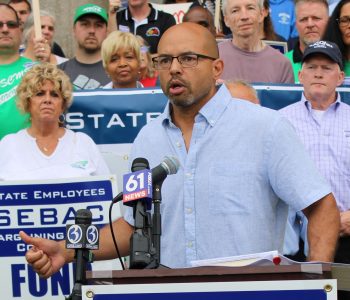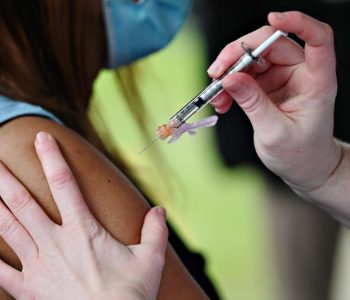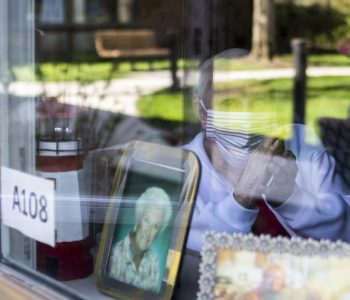For months, Lurlette Newell avoided hugs from her grandchildren, a heartbreaking ordeal for a woman who loves to show affection. But Newell, a certified nursing assistant at the Westside Care Center in Manchester, knew nursing homes had been hit hard by COVID-19, and she was afraid of infecting her family.
“The only thing I could do was wave to them,” she said recently. “It was so painful.”
That changed during the second week of July, when Newell’s employer began the widespread testing of its staff. Newell received her first coronavirus test, which came back negative. She put her arms around her three-year-old grandson and six-year-old granddaughter that week.
“I was so glad,” she said, “because it was heart wrenching.”
The broad testing of nursing home workers and residents is considered a key strategy in fighting the continued spread of COVID-19, which has ravaged those facilities in Connecticut and elsewhere. Deaths among nursing home residents account for 65% of the state’s overall coronavirus fatalities. At least 3,400 staffers have been infected, and more than a dozen have died.
Since May, the state has funded the widespread testing of nursing home employees, setting aside about $30 million for the endeavor. But its contributions will end on Aug. 31.
Who will pay for the testing beyond that – and whether it will continue – is up in the air.
Deidre Gifford, the acting public health commissioner, said the state wants nursing homes to absorb the expense beginning Sept. 1. An executive order signed by Gov. Ned Lamont requires the facilities to test staff on a weekly basis. If a nursing home has been free of COVID-19 for 14 consecutive days, the testing can stop.
“It’s something that, as a cost of doing business, the facilities will need to start taking into account,” Gifford said in an interview. “We don’t have plans in place now to continue it. The nursing home industry in the majority of the rest of the country is paying for these costs.”
But Connecticut nursing home leaders said the facilities, weakened by revenue loss, can’t afford to pick up the tab. During the pandemic, short-term residents who normally are housed two persons to one room have been kept separate as a precaution. The change has cut that source of revenue at least in half. And industry officials say the drop is even greater, since many patients are postponing knee, hip, and other surgeries that require rehabilitation.
Nursing home officials have asked the state to direct more than $300 million in additional support to Connecticut’s 213 facilities.

“Nursing homes understand the state’s strong desire to want to shift the unsustainable and extraordinary cost of testing to the providers, but the timing of that will cause enormous hardship and financial unsustainability,” said Matthew Barrett, president and CEO of the Connecticut Association of Health Care Facilities, which represents 145 homes. “We are still in a pandemic, and our nursing homes have suffered significant revenue losses and increased costs.”
Workers say the uncertainty around the future of testing has left them feeling anxious. Knowing who is sick and who isn’t helps many employees feel safer reporting for their shifts.
At the Westside Care Center, one staff member’s results came back positive during the first round of testing. The worker – a nurse – immediately began isolating. That was a relief to her colleagues, including Newell.
“It makes me feel much more protected that we have been tested,” she said. “And our residents – and my family and friends – are also protected.”
‘We have to find the funding’
By July 15, Gifford said, 43,492 tests had been performed on nursing home staff. Of those, 65 came back positive.
Connecticut has 31,538 workers in those facilities. It was unclear if all employees had received a test by mid-July, but some had been tested more than once. Gifford said the majority of homes had completed at least one round of staff testing.
“We are significantly lower on test positivity in our nursing home staff than we are in the rest of the population that’s being tested in Connecticut,” she told lawmakers during a public hearing last week. “That’s terrific news.”
The positivity rate for the state’s general population hovered between .5% and 1.5%, Gifford said, compared to .15% among nursing home staff.
But while the number of cases has dwindled in recent months, nursing home operators say testing is critical to detecting carriers who show no symptoms.
“Over the last couple months, as residents have been cohorted either by being negative or being recovered and we’ve had at least a somewhat reliable source of personal protective equipment, staff testing is really the linchpin to continuing to keep this at bay,” said David Skoczulek, vice president of business development for the iCare Health Network, which owns 11 nursing homes in and around Hartford. “Hopefully that’s not impacted by financial decisions.”

Workers with SEIU 1199 New England rallied outside the state Capitol this month, asking for more protective equipment for frontline workers, especially those in nursing homes.
YEHYUN KIM :: CT MIRROR
The average cost of a test is $117. Nursing homes are paired with a “care partner” – a local hospital or other facility that provides the testing. The results are reported to the homes and to the Centers for Disease Control and Prevention.
In recent weeks, the Lamont administration has allowed some nursing homes to pause widespread testing of staff. When the governor issued his executive order in June, he mandated the weekly testing of employees in those facilities and in assisted living centers. But soon after, he amended that order to allow nursing homes to stop testing if they’ve been coronavirus free for 14 days. Weekly testing resumes if someone is symptomatic or if a case is recorded among the residents.
The Lamont administration said the change was in line with shifting guidance from the CDC, but the switch has drawn opposition from local legal aid groups. With staff coming and going, they have argued, weekly testing is essential to protecting residents.
And with the state funding scheduled to end in August, many more homes could halt employee testing.
“We have to find the funding to get adequate testing,” said Pedro Zayas, a spokesman for New England Health Care Employees, District 1199 SEIU, which represents about 6,000 nursing home staff members. “Trust me, the workers do not enjoy being tested. It’s not a fun experience. But we’re trying to protect them and the residents from more damage.”
‘When will we be tested again?’
State officials are waiting to see what additional aid they receive from the federal government. The $29.4 million they estimate spending on staff testing through Aug. 31 came from an earlier round of federal funding.
Aside from the money for testing, the state also granted nursing homes a 10% Medicaid rate increase in March at the start of the pandemic. Medicaid covers roughly 70% of all nursing home care provided in Connecticut.

In April, the administration bumped that increase to 15%. And in May and June, Lamont used a portion of Connecticut’s federal Coronavirus Relief Fund allocation to give the homes an effective 20% Medicaid increase each month.
Before the fiscal year ended, the industry had received $52 million from these increases. The administration also set aside more than $70 million in federal dollars for hardship rate increases that homes can apply for – on a facility-by-facility basis – to handle unanticipated costs including overtime, protective gear and equipment replacement.
Despite that, industry leaders are seeking hundreds of millions of dollars to maintain care levels, saying they’ve faced “dramatic revenue losses.” Some homes have begun laying off staff. Officials with SEIU 1199 New England said they were informed of at least 300 nursing home staff layoffs within their union, mostly certified nursing assistants.
Gifford said the state expects the facilities to continue staff testing beyond Aug. 31, tapping every resource available.
“Not all facilities have yet chosen to take advantage of the coronavirus relief grants,” she said. “They also have an option to ask for hardship relief. They can appeal to the Secretary of [the state’s Office of Policy and Management] and in partnership with Department of Social Services, they can ask for additional funding. So there are many avenues available for the industry.”
Long before staff testing was performed widely in nursing homes, employees wanted to be tested. Many regard it as a way of not only caring for themselves and their residents, but also shielding their families. One worker believes she passed the virus to her mother, who died. Another said she infected her late husband.

“Our members will always want to be tested on a regular basis,” said Jesse Martin, a vice president of SEIU 1199 New England. “They know the ultimate price that COVID has caused among the residents and staff. I can count – from my own interactions with the membership – over 30 family members who have died because their loved one who was a nursing home worker contracted COVID at work and brought it home.”
The staff at Newell’s Manchester nursing home received a second round of testing a week after the first. That time, no results came back positive.
“It feels strange being testing, but then I know I’m protected, and my co-workers, my residents and my family members are protected,” Newell said. “I’m worried the testing will end in August. Who is going to do the follow up? When will we be tested again? Those things are very concerning to us.”



